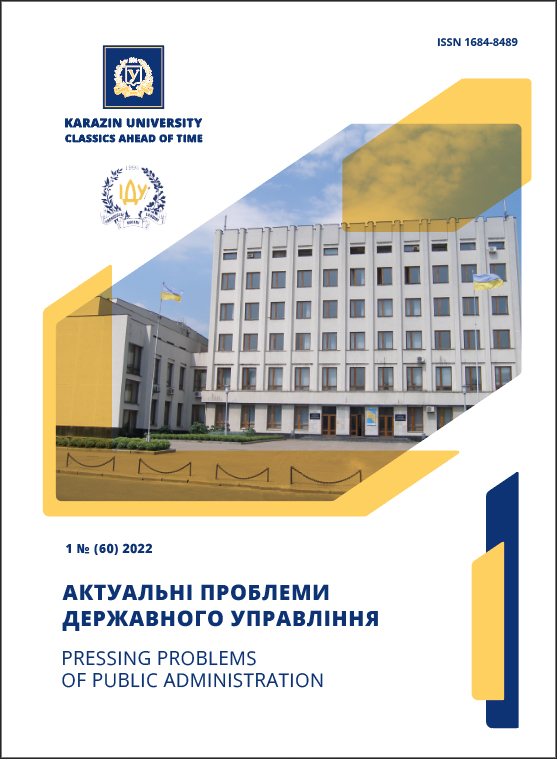ДЕРЖАВНО-ПРИВАТНЕ ПАРТНЕРСТВО ЯК ІНСТРУМЕНТ ІНФРАСТРУКТУРНОГО ВІДНОВЛЕННЯ УКРАЇНСЬКИХ МІСТ
Анотація
Сучасні потреби, вплив цифровізації на суспільні відносини та екологічні
підходи передбачають підвищення вимог до якості та технологічності об’єктів інфраструктури.
Російська воєнна агресія завдала Україні масштабних економічних та гуманітарних втрат, суттєво знищивши критичну інфраструктуру, об’єкти соціального призначення, що потребуватиме величезних зусиль по їх відновленню із залученням ресурсів приватного сектору. Державноприватне партнерство (ДПП) розглядається як перспективний інструмент для реалізації завдань державного сектора. Основні підходи до будівництва інфраструктури на основі моделей державно-приватного партнерства стосуються формування Smart City, сприяючи стійкому та безпечному функціонуванню через спільні взаємозв’язки. Реалізація інноваційних інфраструктурних проєктів з використанням моделей державно-приватного партнерства дозволить прискорити післявоєнне відновлення українських міст, залучити додаткові фінансові та людські.
ресурси, врахувати екологічні, інноваційні та безпекові вимоги до сучасної інфраструктури.
Завантаження
Посилання
Kyivska shkola ekonomiky. (2022). Zahalna suma priamykh zbytkiv infrastruktury zrosla do $114,5 mlrd [Due to the last estimates, damage caused to Ukraine’s infrastructure during the war is $114.5 bln.]. URL: https://kse.ua/ua/about-the-school/news/zagalna-suma-pryamih-zbitkiv-infras-trukturi-zrosla-do-114-5-mlrd/ [in Ukrainian].
Kruhlov, V.V. (2018). Vprovadzhennia mekhanizmiv derzhavno-pryvatnoho partnerst-va v infrastrukturnykh proektakh [Implementation of public-private partnership mechanisms in the infrastructure projects]. Vcheni zapysky Tavriiskoho natsionalnoho universytetu imeni V.I. Vernads-koho. Seriia: Derzhavne upravlinnia – Scientific notes of V.I. Vernadsky Taurida National University. Series: Public administration], 29 (68), 4, 68–73 [in Ukrainian].
Kruhlov, V.V. (2018). Ryzyky proektiv derzhavno-pryvatnoho partnerstva [Risks of public-private partnership projects]. Vcheni zapysky Tavriyskoho natsionalnoho universytetu imeni V.I. Vernadskoho. Seriya: Derzhavne upravlinnya – Scientific notes of V.I. Vernadsky Taurida National University. Series: Public administration, 29(68), 2, 87–91 [in Ukrainian].
IRI. (2021). Some vseukrayinske munitsypalne opytuvannya [Seventh annual ukrainian municipal survey]. URL: https://ratinggroup.ua/files/ratinggroup/reg_files/iri_survey_2021_ua.pdf [in Ukrainian].
Baniasadi, A. and others (2020). Real-life incentives driving public-private partnership in diagnostic services. Ethiopian Journal of Health Sciences, no. 30 (3), 409–416. DOI: http://dx.doi.org/10.4314/ejhs.v30i3.12
Batjargal, T., Zhang, M. (2022). Review on the Public-Private Partnership. Management, no.1 (10), 1–11.
Berglund, E.Z. and others (2020). Smart infrastructure: a vision for the role of the civil engineering profession in smart cities. Journal of Infrastructure Systems, 26 (2), 03120001.
Berrone, P., & Ricart, J.E. (2020). IESE Cities in Motion Index 2020. IESE, Barcelona, Spain. URL: https://media.iese.edu/research/pdfs/ST-0542-E.pdf
United Nations. (2020). Cities and pollution. URL: https:// www.un.org/en/climatechange/climate-solutions/cities-pollution
World Bank. (2022). Country Snapshots. URL: https://ppi.worldbank.org/en/snapshots/country/ukraine.
Dordevic, A., & Rakic, B. (2021). Macroeconomic aspects of public-private partnership. TEME, no. 45 (1), 367–382. DOI: https://doi.org/10.22190/TEME200213020D
Du, J., Wu, H., & Jin, R. (2019). Capital structure of publiceprivate partnership projects: a sustainability perspective. Sustainability, 11 (13), 3505. DOI: https://doi.org/10.3390/su11133505
Fishman, T.D., & Flynn, M. (2018). Using public-private partnerships to advance smart cities. London, UK: Deloitte Center for Government Insights.
Hollands, R.G. (2020). Will the real smart city please stand up?: intelligent, progressive or entrepreneurial? The Routledge companion to smart cities. Routledge, 179–199.
Global Infrastructure Hub. (2022). Infrastructure Monitor 2021. URL: https://cdn.gihub.org/umbraco/media/4740/gihub_v10.pdf
Jayasena, N.S., Chan, D.W.M., & Kumaraswamy, M.M. (2021). A systematic literature review and analysis towards developing PPP models for delivering smart infrastructure. Built Environ. Proj. Asset Manag., 11(1), 121–137. DOI: https://doi.org/10.1108/BEPAM11-2019-0124.17
Jayasena, N.S. and others (2022). Applicability of public-private partnerships in smart infrastructure development: the case of Hong Kong. International Journal of Construction Management. DOI: doi.org/10.1080/15623599.2022.2027076
Liu, T., Mostafa, S., Mohamed, S. & Nguyen, T.S. (2021). Emerging themes of public-private partnership application in developing smart city projects: a conceptual framework. Built Environment Project and Asset Management, 1(11), 138-156. DOI: https://doi.org/10.1108/BEPAM-12-2019-0142
Martin, C. and others (2019). Smart-sustainability: a new urban fix? Sustainable cities and society, 45, 640–648.
The Economist Intelligence Unit. (2022). Measuring the enabling environment for public-private partnerships in infrastructure. URL: https://infrascope.eiu.com/
Mirzaee, A.M., & Sardroud, J.M. (2022). Public-private-partnerships (PPP) enabled smart city funding and financing. Smart Cities Policies and Financing. Elsevier, 117–131.
Nie, X. and others (2021). The evolutionary game of trust in public-private partnership project networks. Mathematical Problems in Engineering. Article D 5514708. DOI: https://doi.org/10.1155/2021/5514708
Nguyen, T.S., Liu, T., Mohamed, S., & Mostafa, S. (2019). Public-private partnership in the context of smart cities: review of contemporary literature. Proceedings of the 43rd Australasian Universities Building Education Association Conference, 704–713. Queensland.
World Bank. (2022). PPI Project Database. URL : http://ppi.worldbank.org.
Regional Economic Prospects. (2022). A cold winter ahead? Confronting the energy crunch. EBRD. URL: https://www.ebrd.com/what-we-do/economic-research-and-data/rep.html.

